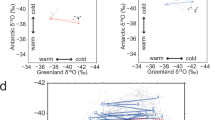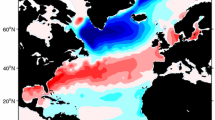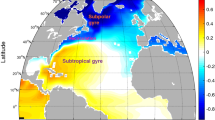Abstract
We have studied the response of the Atlantic meridional overturning circulation to surface freshwater forcing using an ocean GCM coupled to an energy-moisture-balance atmosphere model. The overturning collapses rapidly when a slowly increasing forcing applied to the North Atlantic passes a positive threshold, and spins up equally quickly when the forcing falls below a negative threshold. This well-known behaviour is referred to as hysteresis because the thresholds in forcing are different for the transitions in opposite directions. However, we argue that the behaviour of the Atlantic salinity is more fundamental than the forcing. Hysteresis as a function of freshwater forcing occurs because the states with North Atlantic overturning “on” and “off” each tend to reinforce their associated salinity distributions and inhibit the transition to the other state. During the collapse, the Atlantic becomes less saline because of the import of 80 Sv year of freshwater by ocean transports across 30°S; during the spin-up this freshwater is exported again. We show that qualitatively similar hysteresis behaviour can be produced by perturbing the system without any net freshwater forcing. The salinity flip-flop is associated with the appearance and disappearance of a shallow reverse overturning circulation south of the Equator, which is present while the northern overturning is absent, and may provide the mechanism for the ocean freshwater influx during collapse.









Similar content being viewed by others
References
Bitz CM, Holland MM, Weaver AJ, Eby M (2001) Simulating the ice-thickness distribution in a coupled climate model. J Geophys Res 106: 2441–2464
Bryan F (1986) High-latitude salinity effects and interhemispheric thermohaline circulations. Nature 323: 301–304
Bryan K, Lewis L (1979) A water mass model of the world ocean. J Geophys Res 84: 2503–2517
England MH, Godfrey JS, Hirst AC, Tomczak M (1993) The mechanism for Antarctic Intermediate Water renewal in a world ocean model. J Phys Oceanogr 23: 1553–1560
Gnandesikan A (1999) A simple predictive model for the structure of the oceanic pycnocline. Science 283: 2077–2079
Hughes TMC, Weaver AJ (1994) Multiple equilibria of an asymmetric two-basin ocean model. J Phys Oceanogr 24: 619–637
Kalnay E, Kanamitsu M, Kistler R, Collins W, Deaven D, Gandin L, Iredell M, Saha S, White G, Woollen J, Zhu Y, Chelliah M, Ebisuzaki W, Higgins W, Janowiak J, Mo KC, Ropelewski C, Wang J, Leetmaa A, Reynolds R, Jenne R, Joseph D (1996) The NCEP/NCAR 40-Year Reanalysis Project. Bull Am Meteorol Soc 77: 437–471
Keeling RF, Stephens BB (2001) Antarctic sea ice and the control of Pleistocene climate instability. Paleoceanography 16:112–131 and 330–334
Manabe S, Stouffer RJ (1988) Two stable equilibria of a coupled ocean–atmosphere model. J Clim 1: 841–866
Manabe S, Stouffer RJ (1999a) Are two modes of thermohaline circulation stable? Tellus A 51: 400–411
Manabe S, Stouffer RJ (1999b) The role of the thermohaline circulation in climate. Tellus 51: 91–109
McCartney MS (1977) Subantarctic mode water. In: Angel M (ed) A voyage of discovery. Deep-Sea Res 24 (Suppl): 103–119
Pacanowski RC (1996) MOM 2 documentation user’s guide and reference manual. Version 2.0. Geophysical Fluid Dynamics Laboratory Ocean Tech Rep 3.2
Park YG, Bryan K (2000) Comparison of thermally driven circulations from a depth coordinate model and an isopycnal layer model. Part I: a scaling law – Sensitivity to vertical diffusivity. J Phys Oceanogr 30: 590–605
Rahmstorf S (1996) On the freshwater forcing and transport of the Atlantic thermohaline circulation. Clim Dyn 12: 799–811
Saenko OA, Gregory JM, Weaver AJ, Eby M (2002) Distinguishing the influences of heat, freshwater and momentum fluxes on ocean circulation and climate. J Clim 15: 3686–3697
Saenko OA, Weaver AJ, Gregory JM (2003) On the link between the two modes of the ocean thermohaline circulation and the formation of global-scale water masses. J Clim 16:2797–2801
Schiller A, Mikolajewicz U, Voss R (1997) The stability of the thermohaline circulation in a coupled ocean–atmosphere general circulation model. Clim Dyn 13: 325–347
Schmittner A, Yoshimori M, Weaver AJ (2002) Instability of glacial climate in a model of the ocean–atmosphere–cryosphere system. Science 295: 1489–1493
Stocker TF, Wright DG (1991) Rapid transitions of the ocean’s deep circulation induced by changes in surface-water fluxes. Nature 351: 729–732
Stommel HM (1961) Thermohaline convection with two stable regimes of flow. Tellus 13: 224–230
Thorpe RB, Gregory JM, Johns TC, Wood RA, Mitchell JFB (2001) Mechanisms determining the Atlantic thermohaline circulation response to greenhouse gas forcing in a non-flux-adjusted coupled climate model. J Clim 14: 3102–3116
Vellinga M, Wood RA (2002) Global climatic impacts of a collapse of the Atlantic thermohaline circulation. Clim Change 54: 251–267
Vellinga M, Wood RA, Gregory JM (2002) Processes governing the recovery of a perturbed thermohaline circulation in HadCM3. J Clim 15: 764–780
Weaver AJ, Eby M, Wiebe EC, Bitz CM, Duffy PB, Ewen TL, Fanning AF, Holland MM, MacFadyen A, Matthews HD, Meissner KJ, Saenko O, Schmittner A, Wang H, Yoshimori M (2001) The UVic earth system climate model: model description, climatology, and applications to past, present and future climates. Atmos Ocean 39: 361–428
Wright DG, Stocker TF (1991) A zonally averaged ocean model for the thermohaline circulation. Part I: the model development and flow dynamics. J Phys Oceanogr 21: 1713–1724
Wright DG, Vreugdenhil CB, Hughes TMC (1995) Vorticity dynamics and zonally averaged ocean circulation models. J Phys Oceanogr 25: 2141–2154
Acknowledgements.
We are grateful for discussions with and comments from Robert Thorpe, Richard Wood, Michael Vellinga, Ron Stouffer, Stefan Rahmstorf and an anonymous reviewer. Jonathan Gregory enjoyed the hospitality and stimulating work environment provided by Andrew Weaver and his group during his visit to Victoria in autumn 2001. Work at the Hadley Centre was supported by the UK Department for Environment, Food and Rural Affairs under contract PECD 7/12/37 and by the Government Meteorological Research and Development Programme. Work at the University of Victoria was supported by the Canadian Climate Change Action Fund, the Natural Sciences and Engineering Research Council of Canada, and the Canadian Foundation for Climate and Atmospheric Sciences (through the Canadian CLIVAR program).
Author information
Authors and Affiliations
Corresponding author
Rights and permissions
About this article
Cite this article
Gregory, J.M., Saenko, O.A. & Weaver, A.J. The role of the Atlantic freshwater balance in the hysteresis of the meridional overturning circulation. Climate Dynamics 21, 707–717 (2003). https://doi.org/10.1007/s00382-003-0359-8
Received:
Accepted:
Published:
Issue Date:
DOI: https://doi.org/10.1007/s00382-003-0359-8




